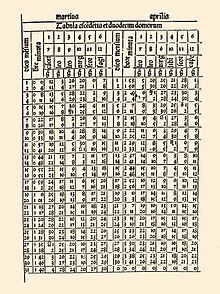Ephemeris
In
The astronomical position calculated from an ephemeris is often given in the
Ephemerides are used in celestial navigation and astronomy. They are also used by astrologers.[4] GPS signals include ephemeris data used to calculate the position of satellites in orbit.
History


- 1st millennium BC – Ephemerides in Babylonian astronomy.
- 2nd century AD – the Almagest and the Handy Tables of Ptolemy
- 8th century AD – the Ibrāhīm al-Fazārī
- 9th century AD – the zīj of Muḥammad ibn Mūsā al-Khwārizmī
- 11th century AD – the zīj of Ibn Yunus
- 12th century AD – the Alfonsine Tables.
- 13th century AD – the Zīj-i Īlkhānī (Ilkhanic Tables) were compiled at the Maragheh observatoryin Persia.
- 13th century AD – the Alfonsine Tables were compiled in Spain to correct anomalies in the Tables of Toledo, remaining the standard European ephemeris until the Prutenic Tablesalmost 300 years later.
- 13th century AD - the Dresden Codex, an extant Mayan ephemeris
- 1408 – Pepysian Library, Cambridge, UK (refer book '1434'); Chinese tables believed known to Regiomontanus).
- 1474 – Regiomontanus publishes his day-to-day Ephemerides in Nürnberg, Germany.[5]
- 1496 – the Almanach Perpetuum of Abraão ben Samuel Zacuto (one of the first books published with a movable type and printing press in Portugal)
- 1504 – While shipwrecked on the island of Jamaica, Christopher Columbus successfully predicted a lunar eclipse for the natives, using the ephemeris of the German astronomer Regiomontanus.[6]
- 1531 – Work of Johannes Stöffler is published posthumously at Tübingen, extending the ephemeris of Regiomontanus through 1551.
- 1551 – the Copernicus's theories.
- 1554 – epicycles, leading to some inaccuracies – for example, periodic errors in the position of Mercury of up to ten degrees. One of the users of Stadius's tables is Tycho Brahe.
- 1627 – the Rudolphine Tables of Johannes Kepler based on elliptical planetary motion became the new standard.
- 1679 – La Connaissance des Temps ou calendrier et éphémérides du lever & coucher du Soleil, de la Lune & des autres planètes, first published yearly by Jean Picard and still extant.
- 1975 –
Modern ephemeris
For scientific uses, a modern planetary ephemeris comprises software that generates positions of planets and often of their satellites, asteroids, or comets, at virtually any time desired by the user.
After introduction of electronic computers in the 1950s it became feasible to use
Typically, such ephemerides cover several centuries, past and future; the future ones can be covered because the field of
Solar System ephemerides are essential for the navigation of spacecraft and for all kinds of space observations of the planets, their natural satellites, stars, and galaxies.
Scientific ephemerides for sky observers mostly contain the positions of celestial bodies in
Scientific ephemerides often contain further useful data about the moon, planet, asteroid, or comet beyond the pure coordinates in the sky, such as elongation to the Sun, brightness, distance, velocity, apparent diameter in the sky, phase angle, times of rise, transit, and set, etc. Ephemerides of the planet Saturn also sometimes contain the apparent inclination of its ring.
An ephemeris is usually only correct for a particular location on the Earth. In many cases, the differences are too small to matter. However, for nearby asteroids or the Moon, they can be quite important.
Other modern ephemerides recently created are the EPM (Ephemerides of Planets and the Moon), from the Russian Institute for Applied Astronomy of the
See also
- Almanac
- American Ephemeris and Nautical Almanac
- The Astronomical Almanac (new name)
- Ephemera
- Ephemeris time
- Epoch (astronomy)
- Epoch (reference date)
- Fundamental ephemeris
- March 0
- Keplerian elements
- Nautical almanac
- Osculating orbit
- Ptolemy's table of chords
- Two-line elements
- William of Saint-Cloud
Notes
- Perseus Project.
- ^ "ephemeris". Merriam-Webster.
- ^ "ephemeris". Dictionnaire Gaffiot latin-français.
- ISBN 978-3-319-59909-0.
- ^ Jones, S.S.D.; Howard, John; William, May; Logsdon, Tom; Anderson, Edward; Richey, Michael. "Navigation". Encyclopedia Britannica. Encyclopædia Britannica, inc. Retrieved 13 March 2019.
- ISBN 9780521411585.
- S2CID 20888261. Retrieved 23 June 2016.
- Victor A. Brumberg, Secular Increase of Astronomical Unit from Analysis of the Major Planet Motions, and its Interpretation Celestial Mechanics and Dynamical Astronomy 90: 267–288, (2004).
- ^ American Practical Navigator: An Epitiome of Navigation. Bethesda, MD: National Imagery and Mapping Agency. 2002. p. 270.
- ^ "Almanacs and Other Publications — Naval Oceanography Portal". United States Naval Observatory. Archived from the original on 27 January 2022. Retrieved 11 November 2016.
- .
- ^ "INPOP10e, a 4-D planetary ephemeris". IMCCE. Retrieved 2 May 2013.
- .
References
- Duffett-Smith, Peter (1990). Astronomy With Your Personal Computer. ISBN 0-521-38995-X.
- "ephemeris". American Heritage Dictionary of the English Language (3rd ed.). Boston: Houghton Mifflin. 1992.
- MacCraig, Hugh (1949). The 200 Year Ephemeris. Macoy Publishing Company.
- Meeus, Jean (1991). Astronomical Algorithms. Willmann-Bell. ISBN 0-943396-35-2.
- Michelsen, Neil F. (1990). Tables of Planetary Phenomena. ACS Publications, Inc. ISBN 0-935127-08-9.
- Michelsen, Neil F. (1982). The American Ephemeris for the 21st Century - 2001 to 2100 at Midnight. Astro Computing Services. ISBN 0-917086-50-3.
- Montenbruck, Oliver (1989). Practical Ephemeris Calculations. ISBN 0-387-50704-3.
- Seidelmann, Kenneth (2006). Explanatory supplement to the astronomical almanac. University Science Books. ISBN 1-891389-45-9.
External links
- The JPL HORIZONS online ephemeris
- Introduction to the JPL ephemerides (archived 26 February 2005)
- "Ephemerides-IMCEE".
